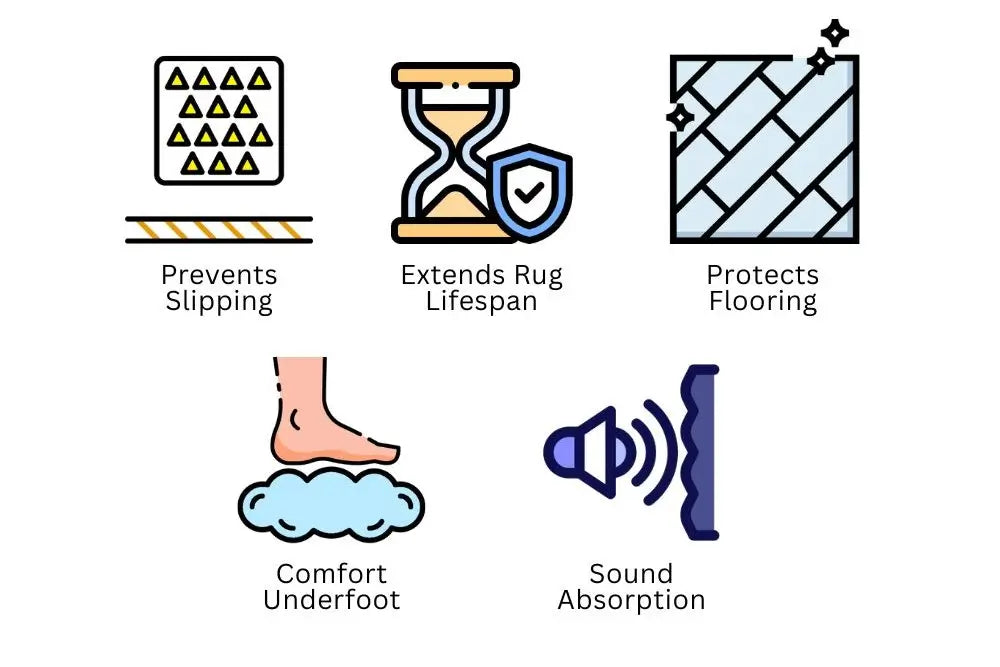What is a Rug Pad?
A rug pad is basically a designed layer that is placed between your rug and the floor to increase the safety, comfort, and durability. Although a rug pad may seem like an optional accessory, it plays a keen role in maintaining the appearance of the rug and also the condition of the flooring beneath it. Moreover, a rug pad provides a cushioning effect, making each and every step feel more comforting and soft, preventing the rug from slipping and bunching, which is a common safety hazard in busy households.
Types of Rug Pads
-

Felt Rug Pads
Felt rug pads are basically cushioned and thick layers made with densely compressed fibers, offering ultimate comfort underfoot. Moreover, felt rug pads are ideal for adding insulation and softness, especially under large area rugs that don't need non-slip backing. These types of rugs are absolutely suited for rugs placed under heavy furniture, as they hold the rug in place through weight rather than grip.
-

Rubber Rug Pads
Well, rubber rug pads usually provide a stronger grip, preventing the rugs from sliding on smooth surfaces like tile or hardwood. These kinds of rug pads are thin and discreet, making them perfect for high-traffic areas where stability is key and also for smaller rugs. These rug pads usually offer less cushioning than felt pads.
-

Memory Foam Pads
Memory foam rug pad usually delivers exceptional softness, molding to the shape of your feet for ultimate comfort. These types of rug pads are usually great for areas where people usually stand, sit, or play on the rug. However, they typically lack a strong grip and hence are better suited for rugs anchored by furniture.
-

Natural Latex Pads
This type of rug pad is made from non-toxic materials, and hence is sustainable, providing an excellent grip while being safe on floors and rugs. Moreover, these rug pads are one of the greatest choices for those who call themselves “environmentally conscious” and hence need durability without synthetic chemicals. These rug pads are basically ideal for humid climates and hence resist mold and mildew.
Why Do You Need a Rug Pad?

Prevents Slipping and Bunching
A rug pad usually keeps your rug firmly in place, preventing it from wrinkling or sliding, which can cause falls or trips. This is essential in high-traffic areas or even homes with children and pets. A rug pad ensures that your rug always stays neatly positioned.
Extends Rug Lifespan
A rug pad acts as a cushioning layer and hence minimizes friction between the floor and the rug. This, in turn, eliminates any kind of wear and tear, helping the rug to maintain its appearance and structure over time. When there’s less stress on the fibers, ultimately it would mean that the rug would stay in good shape for years to come.
Protects Flooring
A rug pad basically acts as a barrier and hence shields the floor from dents, discoloration, and scratches. Moreover, a rug pad also prevents any kind of rough textures or dyes from the rug’s backing from transferring to the floor. This is essential for the polished surfaces as well as for the delicate hardwood.
Enhances Comfort Underfoot
When you buy a quality rug pad, it adds an extra layer of softness, making sitting and walking on the rug even more comforting. Moreover, this comfort is especially noticeable on hard floors such as wood, stone, or tile.
Adds Insulation and Sound Absorption
As per the experts at Bhadohirug, a rug pad helps in reducing the noise in busy spaces and also in retaining the warmth in colder months. Moreover, they also absorb the sound from the footsteps, general activity, and furniture movement. This, in turn, makes them a great choice for multi-level homes and also for apartments.
How to Choose the Right Rug Pad?
-
Based on Flooring Type (Hardwood, Tile, Carpet)
The type of flooring beneath your rug greatly influences the rug pad that you must choose. If the flooring type is hardwood or tile, you must choose natural rubber or felt rubber blends, as they have stronger grips and prevent slipping without damaging the finish.
-
Based on Rug Type (Flatweave, Hand-knotted, Tufted)
Varied rug constructions often require varied pad features. Flatweave rugs require pads that prevent sliding and add cushioning, while the hand-knotted rugs benefit from thinner pads to protect the delicate fibers. Tufted rugs often pair well with felt pads as they provide comfort and support.
-
Based on Size and Placement (Hallways, Under Furniture, Open Areas)
The location of your rug determines the level of cushioning and the grip required. Hallway rugs often require strong non-slip pads for safety in high-traffic areas. Rugs under heavy furniture might not require as much grip, but benefit usually from the cushioned pads to minimize wear, while the open area rugs work best with a combination pad for both stability and comfort.
Rug Pad Maintenance Tips
Here are some simple care tips to keep your rug pad in optimal condition:






